Paleolithic Pebbles Used in Death Rituals Uncovered

Beach pebbles were "killed" 12,000 years ago in death rituals that involved using the stones as spatulas to paint the bodies of the dead, according to excavations in a cave in northern Italy.
The pebbles were uncovered in the Caverna delle Arene Candide, a cave on a steep cliff overlooking the Mediterranean Sea in Liguria.
According to a study published in the Cambridge Archaeological Journal, Paleolithic people living in the area collected oblong pebbles from a nearby beach, used them in the cave to apply ochre onto deceased individuals, and then intentionally broke them.
"The reason for breaking the stones could have been to 'kill' them, discharging them of their symbolic power," co-author Julien Riel-Salvatore, associate professor of anthropology at the University of Montreal, said.
Home to a necropolis containing the remains of some 20 adults and children buried between 13,000 and 11,000 years ago, the cave is located near the present town of Finale Ligure, some 30 miles from Genoa.
RELATED: Gruesome Rituals Revealed in 9,500-Year-Old Graves
The site has been excavated since the 1940s, with archaeologists unearthing more than 600 fragmented pebbles. However, the oblong stones were overlooked and no research was carried out to determine their meaning and function
Sign up for the Live Science daily newsletter now
Get the world’s most fascinating discoveries delivered straight to your inbox.
Researchers at the University of Montreal, Arizona State University and the University of Genoa who excavated a portion of the cave between 2009 and 2011 found 29 limestone pebbles and examined them through macroscopic and microscopic analysis.
It emerged the pebbles were carefully selected on the beach for their polished, flat and oblong morphology. Moreover, traces of ochre were found on the edges and centers of most pebbles, indicating the stones were used as spatulas to decorate the deceased before burial.
The oblong shape allowed "the use of the edges and tip while holding the pebble comfortably and securely in the hand," the researchers wrote.
The funerary ritual ended with the "killing" of the pebbles. Analysis suggested the stones were broken following a specific technique, namely by giving direct blows to their center.

"We experimented by hitting and dropping similarly shaped pebbles in different ways to see which produced the breakage characteristics of the pebbles found in the assemblage," study author Claudine Gravel-Miguel of Arizona State University, told Seeker.
"The pebbles were broken by snapping them on a rock or by hitting their flat surface with a bigger rock," she added.
The "killing" of inanimate objects to break their symbolic power is a well known ritual associated with some prehistoric human burials. Until now, it was thought that this practice only appeared in the Neolithic period in Central Europe, about 8,000 years ago.
"If our interpretation is correct, we've pushed back the earliest evidence of intentional fragmentation of objects in a ritual context by up to 5,000 years," Gravel-Miguel said.
The new evidence may indeed be the earliest instance of ritualistic breakage of artifacts, dating to somewhere between 11,000 and 13,000 years ago.
"At that time people in Liguria were hunter-gatherers but also fishermen. Isotopes analysis of another, much older, burial indicate that 20-25 percent of the food had a marine origin," Roberto Maggi, at Genoa University, told Seeker.
RELATED: Oldest Prostate Stones Suggest a Man Was in Agony 12,000 Years Ago
All of the pebble fragments analyzed by the researchers were missing some matching pieces. They suggest that the missing halves were kept by the living as talismans, souvenirs or mementos, to symbolize lasting bonds to the deceased.
"They might have signified a link to the deceased, in the same way that people today might share pieces of a friendship trinket, or place an object in the grave of a loved one," Riel-Salvatore said.
"It's the same kind of emotional connection," he added.
According to the researchers, archaeologists usually overlook these objects.
"If they see them at a site, they usually go 'Oh, there's an ordinary pebble,' and then discard it with the rest of the sediment," Riel-Salvatore said.
Now the finding could have important implications for research at other Paleolithic sites where pebbles have been found.
As Gravel-Miguel said, "We demonstrated that studying seemingly mundane objects found around burials, instead of focusing only on the burials themselves, can give a new perspective on how people dealt with death in the deep past."
Original article on Seeker.
Most Popular





